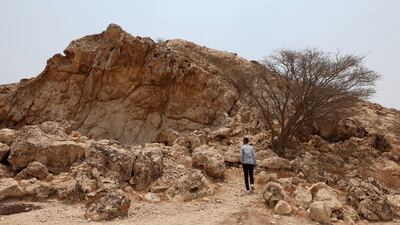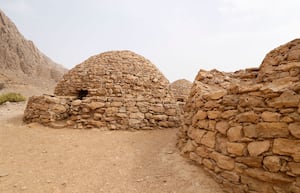It is a matter of pride for any country when it can add to its list of accomplishments a heritage site recognised by the UN Educational, Scientific and Cultural Organisation. The UAE on Friday added a second to its tally of such laurels, with Unesco listing Sharjah’s Faya palaeolandscape – after a collection of Al Ain's cultural sites was added in 2011.
Both these entries are in illustrious company, with the sizeable number of heritage sites in Egypt, Iraq, Lebanon, Saudi Arabia and Jordan, as indeed elsewhere in the Middle East and around the world. The designation of a heritage site adds to a country’s prestige, and indicates its contribution to human culture and history. The buzz that is generated contributes significantly to the local culture and the environment, and invariably boosts local tourism.
The UAE’s listing is likely to generate interest from all who call it home, citizens and residents, including students and hobbyists, as well as overseas enthusiasts who may be inclined to see for themselves what the Faya range looks like up close, and how this chain of limestone outcrops has over several decades helped historians and archaeologists gain a better understanding of human history in this part of the world.
Visitors might want to learn more about, how the site will be preserved and what the responsibility – that comes with the honour of the listing – of its sustainable upkeep will entail.
Such interest can generate a healthy engagement and pride in national heritage.
"For over 210,000 years, this site has borne witness to the story of human innovation, resilience and adaptation in an arid environment,” Sheikha Bodour bint Sultan Al Qasimi, ambassador for the Faya Palaeolandscape World Heritage Nomination, told The National. “As one of the most important archaeological sites around the world, Faya Palaeolandscape is a living testament to humanity’s early presence in this region.”
The Unesco listing – plus the announcement that the Sheikh Zayed National Museum is opening in December – is a further reminder that the UAE, even as it is focused on the future, developing smart technologies and harnessing the power of artificial intelligence, is invested in its past. This is especially significant in a region that has seen immeasurable damage done to places of historical interest through the brutality and destruction of war.
Even amid the extensive destruction of countless sites in the Middle East, however, there are stories of rebirth, in terms of restoration. There are severable notable examples of the UAE’s commitment to preserve its heritage within the borders of the country. But it extends further – for example, in the rehabilitation in northern Iraq of the 12th-century Al Nuri mosque and the two churches, Al Tahera and Al Saa’a, destroyed by ISIS a decade ago.
The UAE donated $50.4 million towards their restoration, along with providing expertise and support and co-ordinating reconstruction.
Such efforts to rehabilitate and give due glory to historic monuments goes a long way in strengthening cultural understanding and imbibing especially in younger generations – some of whom have only seen the very worst of war and humanity – a sense of the past and the imperative of proper respect being accorded to historic sites.
As the UAE takes requisite measures in conserving the Faya palaeolandscape, welcoming visitors and researchers, it becomes an important symbol of remaining connected to the history of the land, and in doing so preserving a significant part of the larger history of the wider world.
The%20specs%20
%3Cp%3E%3Cstrong%3EEngine%3A%20%3C%2Fstrong%3E2.0-litre%204cyl%20turbo%0D%3Cbr%3E%3Cstrong%3EPower%3A%20%3C%2Fstrong%3E261hp%20at%205%2C500rpm%0D%3Cbr%3E%3Cstrong%3ETorque%3A%20%3C%2Fstrong%3E400Nm%20at%201%2C750-4%2C000rpm%0D%3Cbr%3E%3Cstrong%3ETransmission%3A%20%3C%2Fstrong%3E7-speed%20dual-clutch%20auto%0D%3Cbr%3E%3Cstrong%3EFuel%20consumption%3A%20%3C%2Fstrong%3E10.5L%2F100km%0D%3Cbr%3E%3Cstrong%3EOn%20sale%3A%20%3C%2Fstrong%3ENow%0D%3Cbr%3E%3Cstrong%3EPrice%3A%20%3C%2Fstrong%3EFrom%20Dh129%2C999%20(VX%20Luxury)%3B%20from%20Dh149%2C999%20(VX%20Black%20Gold)%3C%2Fp%3E%0A
3%20Body%20Problem
%3Cp%3E%3Cstrong%3ECreators%3A%3C%2Fstrong%3E%20David%20Benioff%2C%20D%20B%20Weiss%2C%20Alexander%20Woo%3C%2Fp%3E%0A%3Cp%3E%3Cstrong%3EStarring%3A%20%3C%2Fstrong%3EBenedict%20Wong%2C%20Jess%20Hong%2C%20Jovan%20Adepo%2C%20Eiza%20Gonzalez%2C%20John%20Bradley%2C%20Alex%20Sharp%3C%2Fp%3E%0A%3Cp%3E%3Cstrong%3ERating%3A%3C%2Fstrong%3E%203%2F5%3C%2Fp%3E%0A
New UK refugee system
- A new “core protection” for refugees moving from permanent to a more basic, temporary protection
- Shortened leave to remain - refugees will receive 30 months instead of five years
- A longer path to settlement with no indefinite settled status until a refugee has spent 20 years in Britain
- To encourage refugees to integrate the government will encourage them to out of the core protection route wherever possible.
- Under core protection there will be no automatic right to family reunion
- Refugees will have a reduced right to public funds
More on animal trafficking
The years Ramadan fell in May
Bareilly Ki Barfi
Directed by: Ashwiny Iyer Tiwari
Starring: Kriti Sanon, Ayushmann Khurrana, Rajkummar Rao
Three and a half stars
Milestones on the road to union
1970
October 26: Bahrain withdraws from a proposal to create a federation of nine with the seven Trucial States and Qatar.
December: Ahmed Al Suwaidi visits New York to discuss potential UN membership.
1971
March 1: Alex Douglas Hume, Conservative foreign secretary confirms that Britain will leave the Gulf and “strongly supports” the creation of a Union of Arab Emirates.
July 12: Historic meeting at which Sheikh Zayed and Sheikh Rashid make a binding agreement to create what will become the UAE.
July 18: It is announced that the UAE will be formed from six emirates, with a proposed constitution signed. RAK is not yet part of the agreement.
August 6: The fifth anniversary of Sheikh Zayed becoming Ruler of Abu Dhabi, with official celebrations deferred until later in the year.
August 15: Bahrain becomes independent.
September 3: Qatar becomes independent.
November 23-25: Meeting with Sheikh Zayed and Sheikh Rashid and senior British officials to fix December 2 as date of creation of the UAE.
November 29: At 5.30pm Iranian forces seize the Greater and Lesser Tunbs by force.
November 30: Despite a power sharing agreement, Tehran takes full control of Abu Musa.
November 31: UK officials visit all six participating Emirates to formally end the Trucial States treaties
December 2: 11am, Dubai. New Supreme Council formally elects Sheikh Zayed as President. Treaty of Friendship signed with the UK. 11.30am. Flag raising ceremony at Union House and Al Manhal Palace in Abu Dhabi witnessed by Sheikh Khalifa, then Crown Prince of Abu Dhabi.
December 6: Arab League formally admits the UAE. The first British Ambassador presents his credentials to Sheikh Zayed.
December 9: UAE joins the United Nations.
UAE currency: the story behind the money in your pockets
PRESIDENTS CUP
Draw for Presidents Cup fourball matches on Thursday (Internationals first mention). All times UAE:
02.32am (Thursday): Marc Leishman/Joaquin Niemann v Tiger Woods/Justin Thomas
02.47am (Thursday): Adam Hadwin/Im Sung-jae v Xander Schauffele/Patrick Cantlay
03.02am (Thursday): Adam Scott/An Byeong-hun v Bryson DeChambeau/Tony Finau
03.17am (Thursday): Hideki Matsuyama/CT Pan v Webb Simpson/Patrick Reed
03.32am (Thursday): Abraham Ancer/Louis Oosthuizen v Dustin Johnson/Gary Woodland



